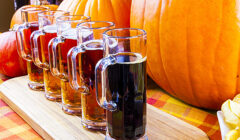Drinking Autumn

Labor Day has come and gone, and the fall-season in central New York has officially begun, bringing with it beautiful landscapes of gold, red, and orange, apple picking, cozy sweaters, football, and Halloween. Autumn also heralds in an ever-expanding array of different flavors and typically darker beers to choose from; thus, as the seasons change, our palates tend to do the same. 
Pumpkin brews are a great autumn choice in bridging from light summer beers into the deep and dark stouts and porters of winter, and while it may seem like pumpkin beers are just another fad-type brew, the origin of pumpkin beer actually dates back to Colonial America. Pumpkins are native to North America and when barley was limited, settlers actually turned to pumpkins because of their high fermentable sugar content. One of the earliest recorded recipes was written in 1771, for “Pompion Ale” by the American Philosophical Society:
“Let the Pompion be beaten in a Trough as Apples. The expressed Juice is to be boiled in a Copper a considerable Time and carefully skimmed that there may be no Remains of the fibrous Part of the Pulp. After that Intention is answered let the liquor be hopped cooled fermented &c. as Malt Beer.”
As the colonies were settled and crops became more plentiful as the years wore on, wheat, barley, and rye became the more prevalent ingredients with which to brew beer. Pumpkins still continued to be used well into the 1800s, but became far less common and eventually kind of died out until the 1980s, when craft beer started to take shape in the US.
Today, pumpkin beer, as we know it, is quite different than the brew of our early American ancestors. Whereas pumpkin was the primary ingredient and took the place of the malts back then, today, our pumpkin beers are brewed primarily with barley and hops with either natural or artificial pumpkin added into the brewing process along with a variety of different spices including cardamom, cinnamon, cloves, ginger and nutmeg; Think less “squash-y” and more along the lines of pumpkin pie. My suggestion is to sample a few different pumpkin beers, because they don’t all taste the same; some are more spiced than others with different concentrations of each spice, some combine other flavors of coffee, bourbon and vanilla with the pumpkin, and some are sweet while others are more savory. The selection is all up to you!

Oktoberfest-style beers are brewed by both the big guns in the beer business as well as the smaller craft breweries this time of year. In summer we’re looking for refreshing, crisp, thirst-quenching brews, but in fall, we naturally turn to heartier, darker brews that lend more character and depth to their flavors. Brews that go with chili and stews, sausages and potatoes, football games, bonfires, and sweaters; thus making these Oktoberfest-style beers a perfect beverage to transition us from summer into the cooler temperatures of autumn and then eventually into winter (and the unofficial start of stout-season!)
What is an Oktoberfest-style beer? At THE Oktoberfest in Munich, Germany all the beer (typically Lagers) served at the event is required to be brewed within the city limits of Munich and the minimum Bavarian Purity Law states that the standard ABV has to be 6%. The color of the beer is anywhere from straw-colored to a light-amber color and filtered. They are also known as “Festbiers.” In the United States, the vast majority of beers that are marketed as “Oktoberfest” beers are Märzen-style beers (and ironically, these darker brews were the original Oktoberfest beer up until about 1990). Märzen brews are medium to full-bodied, richly malty, and have a clean, dry finish. There are usually three different malts used in brewing – Munich, Vienna and Pilsner malts. There are also different variations of Märzen from Helles which is very pale in color, to golden and amber colors of the traditional brew, to Dunkel which is dark brown. ABV usually runs in the 5-6.5% range. Therefore, what we find here in the states is not exactly what they serve at Oktoberfest but there are similarities including the types of malts and hops used to brew said beer; and of course, with all the experimentation that happens in America, there’s no doubt that each brewery will fine-tune their particular Märzen-style brew to be unique in and of itself. Truthfully, the only way to get a 100% traditional Oktoberfest beer is to travel to Munich during the two-week festival and try the beer for yourself!
Lastly, we can’t talk about fall and NOT talk about hard cider! Lucky for us, we live in the heart of apple country and just beyond our small region, the rest of the Northeast also produces massive amounts of apples that are transported throughout the rest of the country, for both consumers and cideries alike.
 Most everyone who went to grade school in the United States has heard of Johnny Appleseed, (or John Chapman, which was his real name), but did you know that those famous seedlings of his during the late 1700s and into the early 1800s weren’t planted for the intention of eating, but instead planted with the intention of creating hard cider? You see, water was not exactly the drink of choice in those early years of the Americas as it wasn’t always safe to drink, especially as settlers traversed the frontier to settle lands west of Pennsylvania. Cider was a much safer and more sanitary alternative and deemed an appropriate beverage for the whole family to consume.
Most everyone who went to grade school in the United States has heard of Johnny Appleseed, (or John Chapman, which was his real name), but did you know that those famous seedlings of his during the late 1700s and into the early 1800s weren’t planted for the intention of eating, but instead planted with the intention of creating hard cider? You see, water was not exactly the drink of choice in those early years of the Americas as it wasn’t always safe to drink, especially as settlers traversed the frontier to settle lands west of Pennsylvania. Cider was a much safer and more sanitary alternative and deemed an appropriate beverage for the whole family to consume.
While truly any variety of apple can be utilized, most hard ciders are ranked from sweet to dry, just like wine. Therefore, different varieties of apples will yield different results along the scale. Apples have acids and tannins, just like grapes, which also contribute to the specific end product that is created.
Apples are harvested when ripe and pressed for the juices. The fresh juice is then collected and placed into tanks, casks, vats, barrels, etc., where simple sugars in the apple juice are converted into ethanol by yeast; these yeast strains can be wild, but most are cultivated strains that are added by the manufacturers. Temperatures at which ciders are created vary anywhere from 60-75 degrees Fahrenheit. Eventually, the yeast is filtered out, and the liquid is strained and placed into a new container. Fermentation continues as it sits and carbon dioxide is created with the remaining sugars, thereby creating carbonation. As well, other flavors, juices and additives can be added during this process of fermentation as well; it is not unusual to find hopped ciders, ciders with additions of honey, cranberries, grapes and even maple syrup! Fermentation can take anywhere from 3 months to 3 years and when it comes time to bottle, fermentation continues to take place in the individual containers. As well, all ciders need to undergo the process of pasteurization during production to kill any harmful bacteria.
Today, craft hard cider is growing as much in popularity as craft beer and with so many different and delightful variations to sample! To note, ciders are also naturally gluten-free, and therefore folks with specific allergies or food sensitivities have a golden opportunity to imbibe right alongside their beer-swigging friends.
This year, celebrate Autumn by packing a few brews into your knapsack for a hike up to the top of a mountain in the Adirondacks and crack them open while admiring the views of fall foliage (just make sure to leave no trace!), or grab your favorite koozie, dress in all the red, white, and blue Zubaz gear you have, and tailgate your literal tail off while grubbing on buffalo wings, subs, hot dogs, all while partaking in an appropriately fall-themed adult-beverage. Truly, there’s no wrong way to celebrate, especially with a brew in hand – Cheers!











